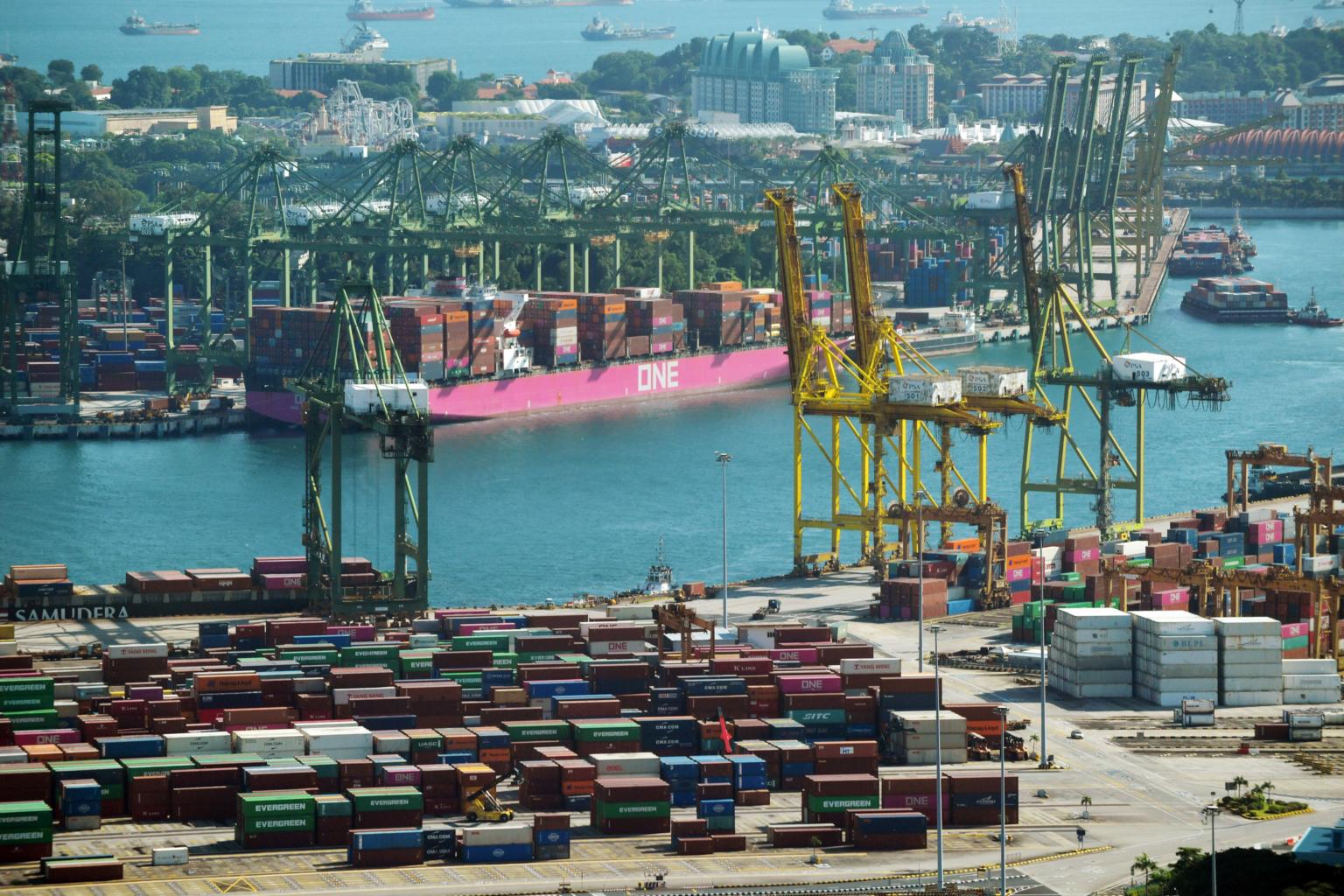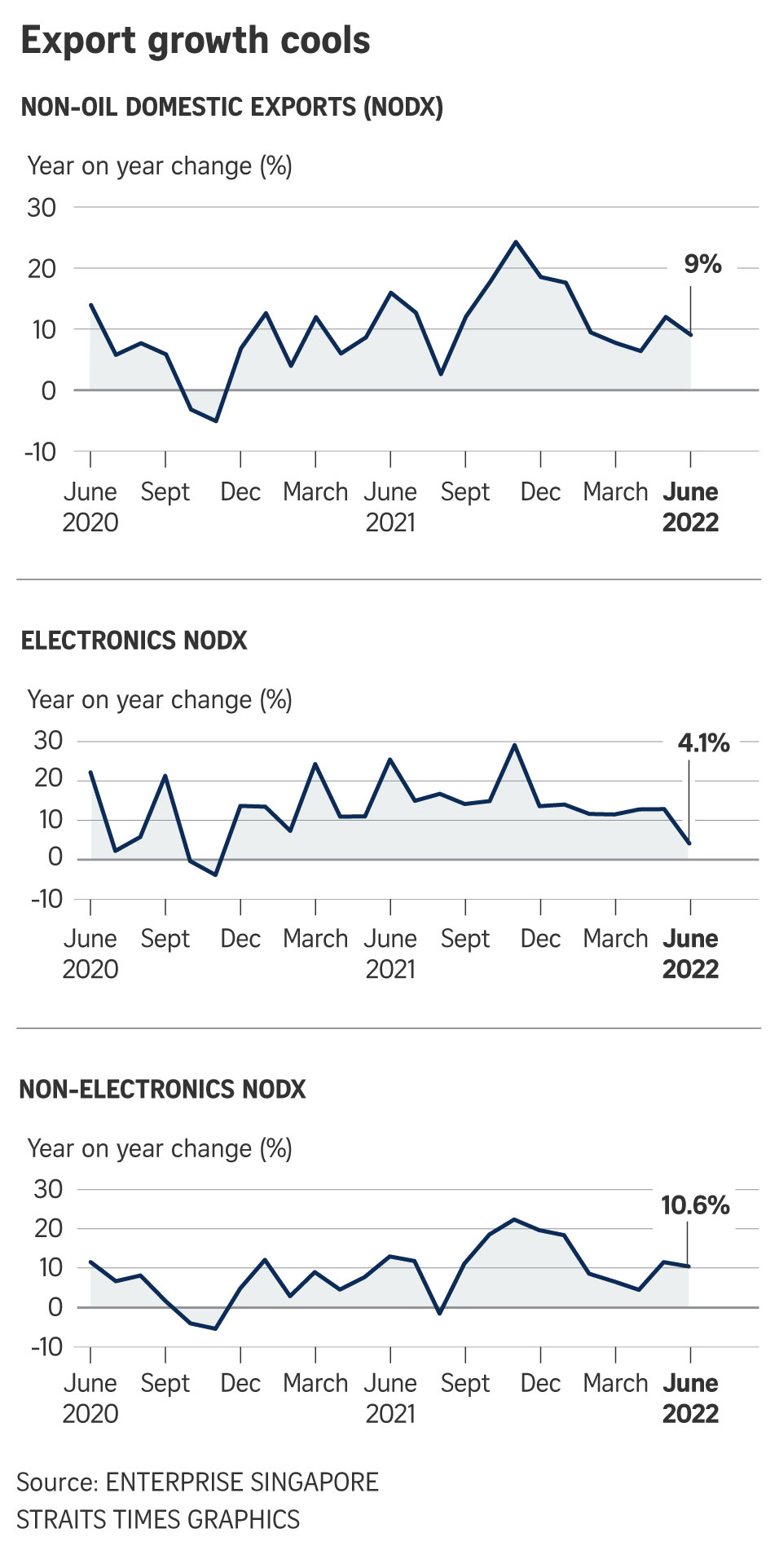Singapore non-oil export growth slows to 9% in June, dragged by electronics
Sign up now: Get ST's newsletters delivered to your inbox

Non-oil domestic exports rose 9 per cent year on year in June.
ST PHOTO: ALPHONSUS CHERN
Follow topic:
SINGAPORE - Singapore's key exports posted slower growth last month, after rising by a revised 12 per cent in May as electronics demand cooled, according to data released by Enterprise Singapore (EnterpriseSG) on Monday (July 18).
Non-oil domestic exports (Nodx) rose 9 per cent year on year in June, expanding for the 19th straight month.
The figure beat the 6.1 per cent growth forecast of analysts polled by Bloomberg.
Electronic shipments rose 4.1 per cent in June, slowing sharply from the 12.9 per cent growth in May.
Maybank economists Chua Hak Bin and Lee Ju Ye noted in a report that the fall in electronic Nodx was due to the drag from parts of personal computers (PCs) and consumer electronics, which have continued to decline because of sluggish demand in the consumer electronics market.
However, shipments of integrated circuits (ICs), parts of ICs and disk drives remained healthy.
The Maybank economists warned that the prices of some ICs are falling and said this could further slow the electronics momentum in the second half.
Other economists are not so concerned by the fallback in electronic shipments.
Mr Irvin Seah, senior economist at DBS Bank, said demand is now getting back to more normal levels after the surge in demand and underinvestment in capacity during the pandemic period.
Mr Khoon Goh, head of Asia research at ANZ, expects electronic export demand to moderate further in the second half of the year to a more sustainable pace of growth, as economic activity in the United States and Europe slows down.
Mr Goh said the kind of growth rates seen last year, where electronic Nodx hit a high of 29.2 per cent last November, is just not sustainable.
Non-electronic Nodx increased by 10.6 per cent last month, following the 11.7 per cent rise in May.
Within non-electronics, pharmaceuticals continued to fall further for the third straight month, down 20.7 per cent in June compared with the 8.6 per cent decline in May.
On a seasonally adjusted basis, Nodx increased by 3.7 per cent month on month in June, after May's 2.8 per cent gain, to reach $17.7 billion.
OCBC Bank chief economist Selena Ling said that Nodx rose 10.2 per cent in the first half of the year.
But as the Maybank economists noted, exports continued to be driven by higher prices rather than volumes.
Singapore's Nodx numbers are stated in nominal terms. Stripping out the effect of higher prices, the Maybank economists said real Nodx based on 2018 prices actually contracted for the fifth straight month in June by 0.5 per cent.
The pace of decline in real Nodx has, however, eased from the 1.3 per cent fall in May.
The Monetary Authority of Singapore's decision last week to tighten monetary policy will make Singapore's exports more expensive in US dollar terms, but economists do not expect this to hurt the Republic's export competitiveness.
Mr Goh said Singapore is a high value-added export nation and thus it is not competing in the low-margin space where currency tends to be more important.
DBS' Mr Seah said a stronger Singapore dollar will help keep the imported costs of intermediate products and raw materials down.
In June, Nodx to the United States, one of Singapore's top 10 markets, rebounded - surging 21.5 per cent after falling 9.6 per cent in May.
Exports to another key market, China, rose 4.8 per cent in June, growing faster than in May as the easing of some Covid-19 restrictions in Shanghai continued to drive a recovery in shipments.
Malaysia and Indonesia continued to be among the top export markets for Singapore, but Thailand fell back, as exports to the country shrank 4.1 per cent in June after the 28.8 per cent growth the previous month.
On the other hand, Singapore's exports to South Korea, Hong Kong and the 27 countries in the European Union continued to fall.
Exports to the EU fell 16.4 per cent in June, with the strengthening Singapore dollar against the euro set to make the Republic's exports to the bloc even more expensive.
Economists told ST that the weakness of the euro, and hence the strength of the Singdollar, is not the main factor impacting export demand to the EU region.
"The spike in energy costs due to the Russian invasion of Ukraine - that has impacted on euro zone growth a lot more compared with other parts of the world," Mr Goh said.
On a year-on-year basis, total trade grew 31 per cent in June, following the 32.1 per cent expansion in May.
Total exports expanded by 29.5 per cent, while total imports grew by 32.5 per cent.
EnterpriseSG expects Nodx to grow 3 per cent to 5 per cent for the whole of 2022.


